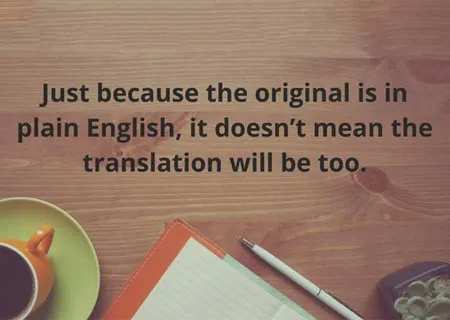Professional Translation Services – Plain English
It’s essential that professional translation services in Australia start placing more emphasis in the accessibility of the translations that we are crafting for our CALD communities. Why? 43.7% of the Australian population has below-proficient literacy levels, and also 26% of Victorians speak a language other than English at home.
Have you ever produced a plain English resource that got translated into a community language?
If the answer is yes, I bet you spent hours and hours polishing the content to ensure it was clear. You probably sent it to some of your colleagues to proofread and might have even done consumer testing.
By the time you sent it to your professional translation services partner, the text was beautifully clear and easy to understand.
And you probably felt relieved that the resource was going to do the job in any translated language. After all, you worked hard to address the low literacy barrier.
If you have been nodding all along…then you should get a chair.
And make yourself comfortable, because you won’t like what you are going to read now.
But it needs to be said.
1. Just because the original is in plain language, it doesn’t mean the translation will be too.
Think about your plain English journey. From the first time you heard about the concept, until now that you are a practicing believer.
Being a plain English practicing believer takes time and effort. If you work in the health space, you probably have some sort of education or training in health literacy.
If you went through this process, you’ll probably know that some writers communicate clearer than others. Although plain language principles are not hard to implement, it takes practice to master them. Do you agree?
So whether your plain English resource will end up being plain Arabic, plain Chinese or plain Spanish…will depend on your translator.
Let me try to convince you with an example:
If we give an English text to 5 NAATI translators, we will end up having 5 different versions of the translation. Some of them will be easier to understand than others.
Some translators, just like some writers, are better at producing clear content.
2. Developing a collaboration relationship with your language translation services will skyrocket translation quality
One of the greatest take-aways of my Translation and Interpreting degree was not to take anything for granted. Translators cannot make assumptions without the right level of due diligence.
If there is important information about your content that could benefit the translation, you need to let your translator know. Also be prepared to answer questions. A good translator will check with the subject matter expert to avoid the risk of misinterpreting an idea.
I find that often organisations rush through the translation process, not placing enough emphasis in the briefing stage.
This is the number one mistake that you can make when working with a translation company.
The better the briefing, the better the outcome.
Every. Single. Time.
3. Knowing and communicating the objective of your resource will help translators set the tone.
Let me take you back to the English resource. Think about how many meetings you had with your team before you even started drafting the structure of the document. One of the main aspects that you would have considered is the objective of the piece. Very basic right?
Would you agree if I say that the objective of the document affected your choice of words? The way you expressed the ideas?
So I’ll confess something now: a resource’s objective is not always easy to pick up. Specially if it’s not even clear for the writer (yep, that happens!). So conveying this to your translations project manager will directly impact the quality of the translation.
And you are probably thinking: ‘if I’ve done a really good job, anyone (including the translator) should be able to know what the objective is”.
Yes. Totally. But why not mitigate the risk and improve potential translation services outcomes by communicating clearly with your translations project manager?
- Translation should be part of a process rather than an isolated task.
I will have to explain this with an example from my involvement in the judging panel of the the ClearMark Awards organised by the Centre for Plain Language in the US. The aim of the awards is to set high standards for clear and simple documents created by government, companies and organisations.
I was part of the Spanish language panel and my role was to shortlist, mark and provide feedback to the different Spanish submissions. As well as having the original and the translated documents, I also had access to detailed information about the development process and evaluation of the resources.
After reviewing the first few submissions, it became obvious to me the relationship between the quality of the final resource and its development process. It was fascinating to see how a beautifully crafted plain English resource ended up being an unclear, hard-to-understand Spanish document.
So I carefully reviewed the development process of a plain language translation in comparison to a hard-to-understand one.
And the outcome was so obvious that it put my world upside down.
Those translations that were produced as a independent document rather than a 100% accurate translation ended up being a lot clearer and targeted to the audience. To produce such a translation, organisations looked at the development team of the English resource, and mirrored it for the Spanish language.
Certified Translation Services
Certified translation services refer to professional translation services that provide official, accurate, and legally valid translations of documents. These services are often required for various legal, immigration, academic, or business purposes. Here are some key aspects of certified translation services:
- Professional Translators: Certified translation services employ experienced and qualified translators who are proficient in both the source and target languages. They have a deep understanding of the subject matter and are capable of producing accurate translations.
- Certification: A certified translation is accompanied by a signed statement or a certificate of accuracy from the translator or the translation agency. This statement attests to the accuracy and completeness of the translation and the qualifications of the translator. It typically includes the translator’s contact information, their credentials, and a statement affirming the accuracy of the translation.
- Legal Validity: Certified translations are often required for legal documents such as birth certificates, marriage certificates, divorce decrees, contracts, and court documents. These translations ensure that the documents can be used for legal purposes in official or government settings.
- Accuracy: Certified translations aim to maintain the same level of precision and faithfulness to the source text as the original document. Any errors or discrepancies can have serious consequences, so accuracy is paramount.
- Confidentiality: Certified translation services should maintain strict confidentiality when handling sensitive or confidential documents. Translators and agencies should have robust privacy and data protection policies in place.
- Specialization: Some certified translation services specialize in specific fields, such as medical, legal, technical, or financial translation. This ensures that the translator is well-versed in the terminology and requirements of the particular industry.
- Notary Services: In some cases, certified translations may need to be notarized. This involves having a notary public witness the translator’s signature on the certificate of accuracy, further verifying the authenticity of the translation.
- Languages Supported: Certified translation services typically offer translations for a wide range of languages, depending on the needs of their clients.
- Turnaround Time: The time it takes to complete a certified translation can vary depending on the complexity and volume of the document. Clients should inquire about the estimated turnaround time when requesting a quote.
- Cost: The cost of certified translation services can vary based on factors such as the language pair, document complexity, and urgency. It’s advisable to request a quote from the service provider before proceeding.
When in need of certified translation services, it’s essential to choose a reputable agency or translator with a track record of delivering accurate and certified translations for your specific requirements. Additionally, always check with the relevant authorities or organizations to ensure that the certified translation will meet their specific criteria and requirements.
So here is the thing:
If the English resource was produced in collaboration between a subject matter expert, a communications specialist, a plain language editor, etc…
why do we expect one single translator to produce the same results?
Sounds pretty obvious, right?
You can read more on my experiment here.
As you can see, there is a lot more to professional translation services than just writing the original in plain English. If you really want your resources to make an impact and deliver real results, we’ll be happy to hear from you.. You can also visit our page about our plain English translators.
Related Posts

Get a quote today
"*" indicates required fields
Subscribe today to receive the latest insights and updates from Sylaba Translations










